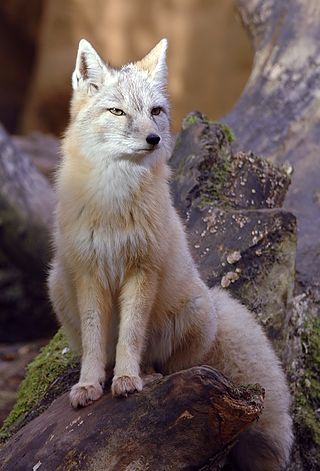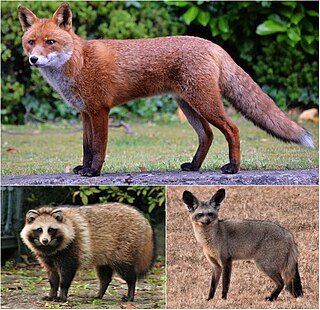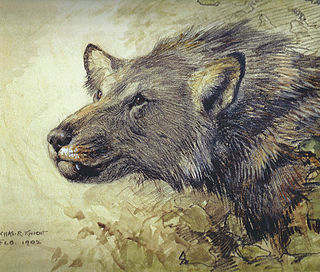
Canidae is a biological family of dog-like carnivorans, colloquially referred to as dogs, and constitutes a clade. A member of this family is also called a canid. The family includes three subfamilies: the Caninae, and the extinct Borophaginae and Hesperocyoninae. The Caninae are known as canines, and include domestic dogs, wolves, coyotes, foxes, jackals and other species.

Urocyon is a genus of Canidae which includes the gray fox and the island fox. These two fox species are found in the Western Hemisphere. Whole genome sequencing indicates that Urocyon is the most basal genus of the living canids. Fossils of what is believed to be the ancestor of the gray fox, Urocyon progressus, have been found in Kansas and date to the Upper Pliocene, with some undescribed specimens dating even older.

The South American foxes (Lycalopex), commonly called raposa in Portuguese, or zorro in Spanish, are a genus from South America of the subfamily Caninae. Despite their name, they are not true foxes, but are a unique canid genus more closely related to wolves and jackals than to true foxes; some of them resemble foxes due to convergent evolution. The South American gray fox, Lycalopex griseus, is the most common species, and is known for its large ears and a highly marketable, russet-fringed pelt.

Nyctereutes is a genus of canid which includes only two extant species, both known as raccoon dogs: the common raccoon dog and the Japanese raccoon dog. Nyctereutes first entered the fossil record 5.5 million years ago (Mya) in northern China. It was one of the earliest canines to arrive in the Old World. All but two species became extinct before the end of the Pleistocene. A study suggests that the evolution of Nyctereutes was influenced by environmental and climatic changes, such as the expansion and contraction of forests and the fluctuations of temperature and precipitation.

The side-striped jackal is a canine native to central and southern Africa.

The corsac fox, also known simply as a corsac, is a medium-sized fox found in steppes, semi-deserts and deserts in Central Asia, ranging into Mongolia and northern China. Since 2004, it has been classified as least concern by IUCN, but populations fluctuate significantly, and numbers can drop tenfold within a single year. It is also known as the steppe fox. The word "corsac" is derived from the Russian name for the animal, "korsák" (корса́к), derived ultimately from Turkic "karsak".

Cynodesmus is an extinct genus of omnivorous canine which inhabited North America during the Oligocene living from 33.3—-26.3 Ma and existed for approximately 7 million years.

Vulpini is a taxonomic rank which represents the fox-like tribe of the subfamily Caninae, and is sister to the dog-like tribe Canini.

Caninae is the only living subfamily within Canidae, alongside the extinct Borophaginae and Hesperocyoninae. They first appeared in North America, during the Oligocene around 35 million years ago, subsequently spreading to Asia and elsewhere in the Old World at the end of the Miocene, some 7 million to 8 million years ago.
Nothocyon is an extinct genus of carnivoran in the family Subparictidae which inhabited North America during the late Oligocene. At one time, many species of the dog family Canidae were placed in Nothocyon, but new fossils showed that the type species of Nothocyon, N. geismarianus, is more closely related to bears. The other species have been reassigned to other genera such as Cormocyon.

Cynarctus is an extinct genus of the Borophaginae subfamily of canids native to North America. The genus was first founded by W. D. Matthew in 1901, based from a pair of lower jaws, Cynarctus saxitilis, found in the Pawnee Creek Beds of Colorado. It lived during the Middle to Late Miocene 16.0—10.3 mya, existing for approximately 5.7 million years. Fossils have been uncovered in Colorado, California, Maryland, western Nebraska, and Texas. It was likely an omnivore, and lacked the bone-cracking adaptations found in some later borophagines. Newer findings have proved the genus to be described as a large dog-like raccoon, a result from combining characteristics from Canidae with Procyonidae.

Xenocyon is an extinct group of canids, either considered a distinct genus or a subgenus of Canis. The group includes Canis (Xenocyon) africanus, Canis (Xenocyon) antonii and Canis (Xenocyon) falconeri that gave rise to Canis (Xenocyon) lycanoides. The hypercarnivorous Xenocyon is thought to be closely related and possibly ancestral to modern dhole and the African wild dog, as well as the insular Sardinian dhole.

Canis lepophagus is an extinct species of canid which was endemic to much of North America during the Early Pliocene. It is notable because its lineage is proposed to have led to both wolves and coyotes.
Borophagus parvus is an extinct species of the genus Borophagus, of the subfamily Borophaginae, a group of canids endemic to North America from the late Hemphillian of the Miocene epoch through the Pliocene epoch 10.3—4.9 Ma, existing for approximately 5.4 million years.
Borophagus dudleyi is an extinct species of the genus Borophagus of the subfamily Borophaginae, a group of canids endemic to North America from the late Hemphillian of the Miocene epoch through the Pliocene epoch. Borophagus dudleyi existed for approximately 5.4 million years.

Borophagus hilli is an extinct species of the genus Borophagus of the subfamily Borophaginae, a group of canids endemic to North America from the Late Miocene until the Pliocene.

Borophagus diversidens is an extinct species of the genus Borophagus of the subfamily Borophaginae, a group of canids endemic to North America from the late Miocene epoch through the Pliocene epoch 4.9—1.8 Ma.

A hypocarnivore is an animal that consumes less than 30% meat for its diet, the majority of which consists of fungi, fruits, and other plant material. Examples of living hypocarnivores are the grizzly bear, black bear, binturong and kinkajou

Eucyon is an extinct genus of medium omnivorous coyote-like canid that first appeared in the Western United States during the late Middle Miocene 10 million years ago. It was the size of a jackal and weighed around 15kg. It was one of the few North American mammals which invaded Eurasia about 6 million years ago, followed by the genus going extinct 3 million years ago. This genus is proposed to have given rise to genus Canis 6 million years ago.

Lycaon is a genus of canid which includes the African wild dog and the extinct species Lycaon sekowei and Lycaon magnus.
















